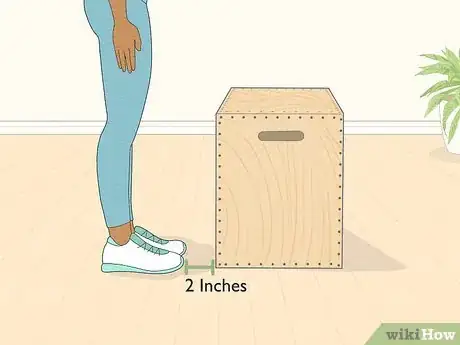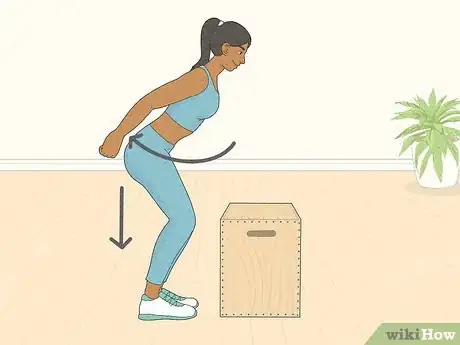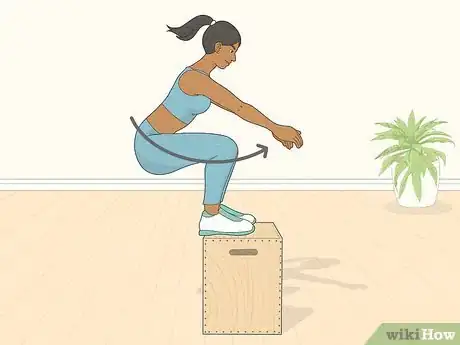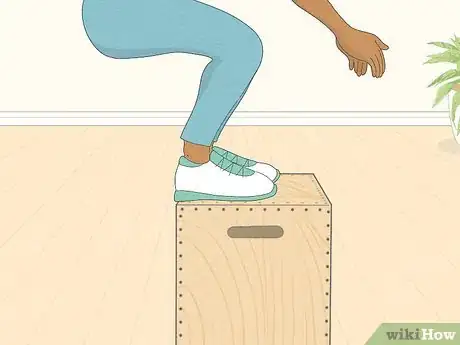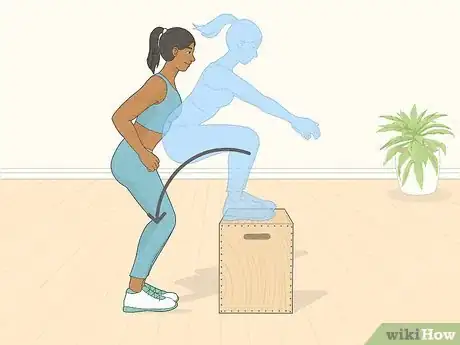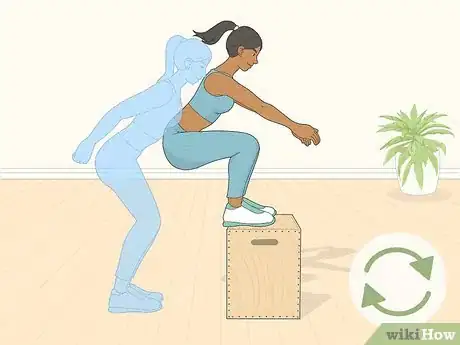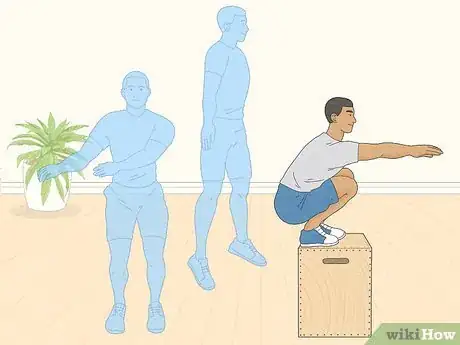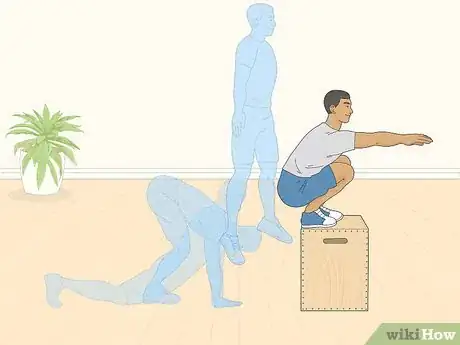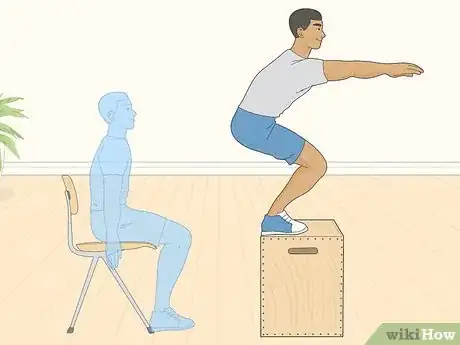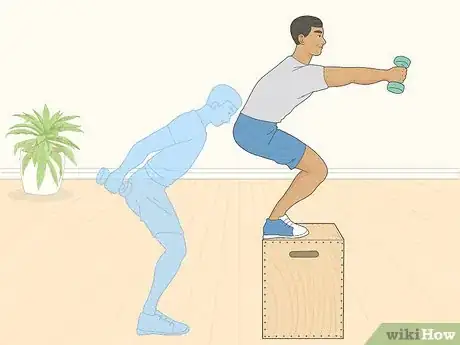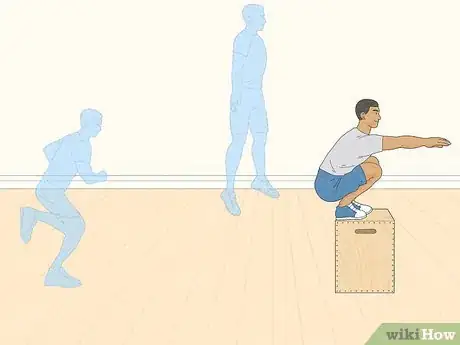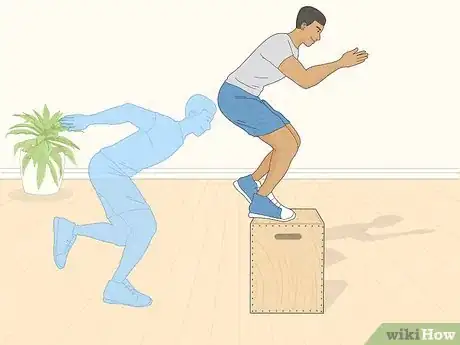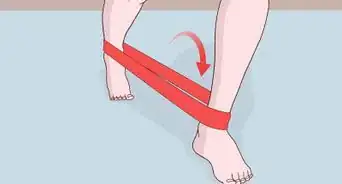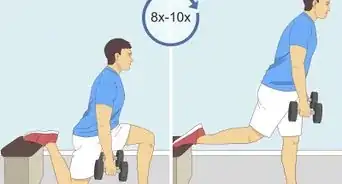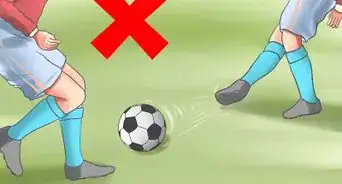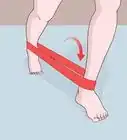This article was co-authored by Eric Martinez and by wikiHow staff writer, Janice Tieperman. Eric Martinez is a Registered Clinical Exercise Physiologist and the Vice President of Infinity Sports Institute in Miami, Florida. With over a decade of experience, Eric specializes in clinical exercise physiology, human optimization, and sports science. He works with professional and Olympic athletes as well as high-risk patients. Eric holds an MS in Exercise Physiology from Barry University and is a Registered Clinical Exercise Physiologists in the State of Florida. Eric holds 15 different certifications in specialties such as strength and conditioning, injury prevention, neuro biomechanics, and Kinesio taping. He trains hundreds of coaches in Nero and Clinical Physiology certifications.
There are 11 references cited in this article, which can be found at the bottom of the page.
This article has been viewed 19,509 times.
Box jumps are a fun twist to your usual leg workout, and are great for building muscle in your hamstrings, quads, calves, and glutes. The box jump is a great exercise for just about anyone, whether you’re a weightlifter, competitive athlete, strength trainer, or someone just looking to change up their fitness routine.[1] This exercise is very easy to learn, as long as you take the right precautions.
Steps
Basic Jump
-
1Set down a sturdy box that’s 30 in (76 cm) or shorter. Grab a box that’s large and sturdy enough for you to comfortably stand on. This box doesn’t have to be super tall—in fact, it’s better to choose a box that’s 30 in (76 cm) or shorter. If you don’t have a box on hand, check online or pick one up from a sports equipment shop.
-
2Stand 1 to 2 in (2.5 to 5.1 cm) behind the box with your legs hip-width apart. Align your ankles, knees, and hips in a straight line so you aren’t off-kilter when you start the exercise.[4]
- Don’t keep your feet together or spread your feet too far apart. Instead,
Advertisement -
3Lower your hips and swing your arms backward to “load” your legs. Bring your hips back, bending your knees slightly forward at a 45-degree angle. Lean forward, angling your back at a 45-degree angle while swinging your arms behind you. Keep both feet hip-width apart as you prepare to jump.[5]
- “Loading” is a fancy term for building momentum in your legs. This momentum will help you complete the box jump rep.
-
4
-
5Flex your knees, hips, and ankles when you land to brace the impact. Keep your balance as you land on the box. Don’t straighten your legs as soon as you land—instead, keep your muscles flexed so they absorb the impact.[8]
- Try to land on the box as softly as you can. You put extra strain on yourself when you land with a loud thump.
-
6Hop off the box to reset the exercise. Don’t do a backwards version of the box jump. Instead, straighten your legs and hop back onto ground, returning to your starting position.
-
7Try 3-4 sets of 3-5 box jump reps. Box jumps can take a big toll on your legs, so don’t do too many at once. Start with a few sets of 3-5 box jumps, giving yourself 2-3 minutes to rest in between each set.[9] If you start feeling tired, don’t push through to the end of the set—just wrap things up wherever you are.
- A “rep” is a single box jump. A “set” is a series of box jumps done one after the other.
- If you’d like to focus on muscle endurance, try 2-3 sets with 8-12 reps, giving yourself 60-90 seconds to rest between each set.
Variations
-
1Twist in mid-air to do a rotational box jump. Instead of facing the box, turn yourself 90 degrees to the left or right. Lower your hips and jump into the air. As you leap, turn yourself 90 degrees so you’re facing forward as you land on the box.[10]
-
2Do a burpee before each box jump rep. Stand directly in front of the box and lower yourself into a push-up position. Do a single push-up, and jump back to a standing position. Then, segue into a box jump rep as you usually would.[11]
- Give yourself a second to get your bearings before transitioning into the box jump.
-
3Try a box jump from a seated position. Pull up a chair or stool and sit in front of the box. Then, rise up from the seat and immediately jump onto the box. This version is extra challenging since you don’t “load” your muscles ahead of time.[12]
- You can swing your arms while jumping or leave them at your sides—the choice is yours!
- Arrange the seat 2 ft (0.61 m) or so behind the box, so you have enough room to jump up.[13]
-
4Hold some weights while doing a box jump. Pick up light dumbbells that you can hold without straining yourself. Lower your hips and jump onto the box as usual while swinging the weights for extra resistance.[14]
- If you aren’t comfortable using weights, slide into a weighted vest instead.
-
5Challenge yourself with a 2-step box jump. Back yourself up so you’re about 3⅓ ft (1 m) behind the box. Jump forward once to bridge the distance, and then leap onto the box as usual. This variation can be a little tricky, so don’t try it until you’ve mastered the basics.[15]
- Some people use 2-step box jumps to leap onto taller boxes. Be very careful if you experiment with a taller platform![16]
-
6Balance on 1 leg while doing a box jump. Center your weight on 1 foot, leaving your other foot 1 to 2 in (2.5 to 5.1 cm) off the ground. Lower your hips and launch yourself up onto the box, landing on 1 leg instead of 2.[17]
- Feel free to lean on your other leg if you’re worried about losing your balance.
Expert Q&A
-
QuestionIs it better to use a bigger box or a smaller box?
 Eric MartinezEric Martinez is a Registered Clinical Exercise Physiologist and the Vice President of Infinity Sports Institute in Miami, Florida. With over a decade of experience, Eric specializes in clinical exercise physiology, human optimization, and sports science. He works with professional and Olympic athletes as well as high-risk patients. Eric holds an MS in Exercise Physiology from Barry University and is a Registered Clinical Exercise Physiologists in the State of Florida. Eric holds 15 different certifications in specialties such as strength and conditioning, injury prevention, neuro biomechanics, and Kinesio taping. He trains hundreds of coaches in Nero and Clinical Physiology certifications.
Eric MartinezEric Martinez is a Registered Clinical Exercise Physiologist and the Vice President of Infinity Sports Institute in Miami, Florida. With over a decade of experience, Eric specializes in clinical exercise physiology, human optimization, and sports science. He works with professional and Olympic athletes as well as high-risk patients. Eric holds an MS in Exercise Physiology from Barry University and is a Registered Clinical Exercise Physiologists in the State of Florida. Eric holds 15 different certifications in specialties such as strength and conditioning, injury prevention, neuro biomechanics, and Kinesio taping. He trains hundreds of coaches in Nero and Clinical Physiology certifications.
Clinical Performance Specialist & Registered Clinical Exercise Physiologist Clinical Performance Specialist & Registered Clinical Exercise PhysiologistExpert AnswerSo long as the box is stable, the size doesn't really matter all that much. It's more about how high you're jumping, and the size of the box doesn't really impact that.
Clinical Performance Specialist & Registered Clinical Exercise PhysiologistExpert AnswerSo long as the box is stable, the size doesn't really matter all that much. It's more about how high you're jumping, and the size of the box doesn't really impact that. -
QuestionWhat can I do if I'm really bad at box jumps?
 Eric MartinezEric Martinez is a Registered Clinical Exercise Physiologist and the Vice President of Infinity Sports Institute in Miami, Florida. With over a decade of experience, Eric specializes in clinical exercise physiology, human optimization, and sports science. He works with professional and Olympic athletes as well as high-risk patients. Eric holds an MS in Exercise Physiology from Barry University and is a Registered Clinical Exercise Physiologists in the State of Florida. Eric holds 15 different certifications in specialties such as strength and conditioning, injury prevention, neuro biomechanics, and Kinesio taping. He trains hundreds of coaches in Nero and Clinical Physiology certifications.
Eric MartinezEric Martinez is a Registered Clinical Exercise Physiologist and the Vice President of Infinity Sports Institute in Miami, Florida. With over a decade of experience, Eric specializes in clinical exercise physiology, human optimization, and sports science. He works with professional and Olympic athletes as well as high-risk patients. Eric holds an MS in Exercise Physiology from Barry University and is a Registered Clinical Exercise Physiologists in the State of Florida. Eric holds 15 different certifications in specialties such as strength and conditioning, injury prevention, neuro biomechanics, and Kinesio taping. He trains hundreds of coaches in Nero and Clinical Physiology certifications.
Clinical Performance Specialist & Registered Clinical Exercise Physiologist Clinical Performance Specialist & Registered Clinical Exercise PhysiologistExpert AnswerYou could start adding hip mobility drills, which refers to any exercise that involves you lifting your hip up, you'll get a similar benefit. It's also a good idea to start with something like this if you're brand new to this activity, since it tends to be a pretty high-impact activity.
Clinical Performance Specialist & Registered Clinical Exercise PhysiologistExpert AnswerYou could start adding hip mobility drills, which refers to any exercise that involves you lifting your hip up, you'll get a similar benefit. It's also a good idea to start with something like this if you're brand new to this activity, since it tends to be a pretty high-impact activity.
Warnings
- Never stack your boxes. This is really dangerous, and you can get seriously hurt if the boxes shift or slip during the exercise.⧼thumbs_response⧽
References
- ↑ https://www.teamusa.org/USA-Weightlifting/BarBend/2019/February/15/Box-Jump-Exercise-Guide
- ↑ https://m.youtube.com/watch?v=hxldG9FX4j4&t=0m33s
- ↑ Eric Martinez. Clinical Performance Specialist & Registered Clinical Exercise Physiologist. Expert Interview. 18 May 2021.
- ↑ https://www.teamusa.org/USA-Weightlifting/BarBend/2019/February/15/Box-Jump-Exercise-Guide
- ↑ https://m.youtube.com/watch?v=hxldG9FX4j4&t=1m40s
- ↑ https://www.teamusa.org/USA-Weightlifting/BarBend/2019/February/15/Box-Jump-Exercise-Guide
- ↑ https://m.youtube.com/watch?v=4VJynYzr3w4&t=0m48s
- ↑ https://www.teamusa.org/USA-Weightlifting/BarBend/2019/February/15/Box-Jump-Exercise-Guide
- ↑ https://www.teamusa.org/USA-Weightlifting/BarBend/2019/February/15/Box-Jump-Exercise-Guide
- ↑ https://m.youtube.com/watch?v=Sxz2gLBtu94&t=0m1s
- ↑ https://m.youtube.com/watch?v=QJTztnjOoMM&t=0m11s
- ↑ https://www.teamusa.org/USA-Weightlifting/BarBend/2019/February/15/Box-Jump-Exercise-Guide
- ↑ https://m.youtube.com/watch?v=S1BOv-JwZUA&t=2m37s
- ↑ https://www.coachmag.co.uk/leg-exercises/6458/how-to-do-box-jumps
- ↑ https://www.coachmag.co.uk/leg-exercises/6458/how-to-do-box-jumps
- ↑ https://m.youtube.com/watch?v=5wo9heQaLK4&t=0m3s
- ↑ https://m.youtube.com/watch?v=23bE1TcS32U&t=0m2s
About This Article
To do box jumps, first find a sturdy box that’s about 30 inches (76 cm) or shorter and place it on a flat surface where it won't slide around. Stand facing the box about 1-2 inches (2.5-5 cm) away with your feet shoulder-width apart. Then, bend your knees, push your hips back, and bring your arms behind you to wind up for your jump. Push off of the ground hard while driving your arms forward to jump onto the box. Land with both feet at the same time and stay partly squatted to soften your impact. Keep your back straight as you land. Then, stand up straight and step back down to your starting position. Avoid jumping back down since you could injure yourself. Repeat the process, aiming for around 3 to 4 sets of 3 to 5 reps.


